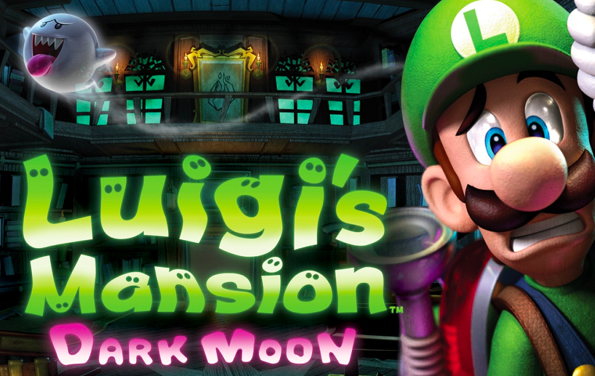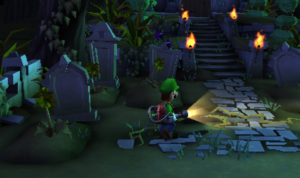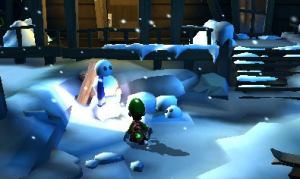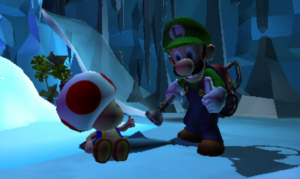[Review] Luigi’s Mansion: Dark Moon

Author: Laura
We’ve had games that show off Luigi’s great personality before– like Mario is Missing and, of course, what started it all: Luigi’s Mansion— but none so far have shown how much personality Luigi really has. Nintendo has stated that 2013 is “The Year of Luigi”, and nothing could have launched that better than Luigi’s Mansion: Dark Moon.

The story begins in the laboratory of Professor E. Gadd (the quirky, goblin-esque doctor who helps Luigi out in the first game) where he and his poltergeist pals are hard at work on… something. Suddenly King Boo shoots a magical purple beam at the moon and eerie clouds start to creep in over all of Evershade Valley (home to five brand new mansions; Luigi’s original mansion is not present). All of the once-friendly ghosts lose their happy-go-lucky attitudes and turn into rebellious, havoc causing fiends! So, who you gonna call? LU-IGI!
Well E. Gadd doesn’t really “call” him per say, more like “hacks into Luigi’s TV and sucks him through it into his secret tiny bunker”. He then begins to explain that the “Dark Moon” that once shone brightly above has been broken into pieces and scattered all over Evershade Valley. Go figure. Next step, he equips Luigi with a flashlight and a communicator that looks eerily familiar and is called the “Dual Scream”…you follow me? (If not: Luigi is given an original DS, which shows you his map and allows you to answer calls from E. Gadd himself.)
Now its time to go and recover all of the pieces of the Dark Moon that remain.

Each Dark Moon piece is located in a different mansion throughout the valley. It starts with the classic haunted mansion, and moves on through different elements such as desert and snow. To the dismay of some Luigi’s Mansion fans, each mansion is divided into chapters, giving the game a choppier feel than its predecessor. I, however, thought it fit perfectly with it being a handheld game because the chapters helped break it up so I could take breaks without forgetting what my next move was. On the flip side, it can also lead to hours of annoying trials, as there are no checkpoints.
In the first mansion you will obtain two new attachments for the flashlight: The “Strobulb” allows players to release a burst of light, revealing and stunning the ghosts to give you a chance to vacuum them up. When they’re stunned, their health level will appear and Luigi will have to hold on for dear life until the level has reached zero. It is the same concept as the first game but with the 3DS being smaller and easier to handle than the Gamecube controller, catching ghosts is a lot simpler. The second attachment is the “Dark-Light”, which is needed to find objects that have been turned invisible by naughty Boos. Both accessories strive to give the player more control, but can honestly get tiring to use after a while.
Also, the gameplay layout is the same throughout every level. Enter a room, see a ghost (or ghosts), flash ‘em, and suck those bad boys up. It is much easier to control compared to the first Luigi’s Mansion, but can get tedious. You’re required to use the gyroscope to look up and down when ghostcatching, while at the same time reeling them in, and I felt like the gyro controls were a bit forced in the games entirety. At some points you have to cross beams using the gyroscope mechanism, and believe me, you can lose a crazy amount of health just from failing over and over again due to how sensitive it is.

There are a couple of collectibles found in every mansion, like coins, dollar bills and gold bricks. They’re found pretty much everywhere just by touching a vase or sucking up ghosts, and after collecting enough money, you can find a “Golden Bone” which is essentially an extra life. When you die, our faithful ol’ Polterpup (a cute, not so furry companion that sometimes leads Luigi on wild goose chases through a mansion) comes around, sniffs out the bone, and licks you to wake you up. It is an excellent second chance system that perfectly matches the charm of the rest of the game.
“Gems” are another type of collectible found throughout the game. The “type” of Gem you can find is different in each mansion– for example, you collect Amethysts in the introductory mansion– and they can be tricky to find, some being hidden by manipulative objects or requiring you to figure out small puzzles with the tools Luigi has. There are a total of sixty-five gems in the entire game, but honestly, they hardly add anything to the experience.
Also hidden in each location is a Boo you can find and capture as a small side-quest. You can only find one Boo per chapter and they can sometimes be very challenging to locate, which can be good or bad depending on whether or not you mind replaying a level to try and find ones you missed. Using the “Dark-Light”, you uncover an invisible object and “BOO!” a… Boo pops out. It will suddenly disappear and you must follow it with the “Dark-Light” until you’ve sucked it up with your Poltergeist 5000. I myself enjoy collectibles and side quests of sorts, but unfortunately Dark Moon is a quite lacking terms of the rewards you can receive for collecting such things. You can upgrade your flashlight’s health bar and your Poltergeist 5000 with the money you gain, but otherwise that’s it for earning things.

Most of the charm of Luigi’s Mansion: Dark Moon comes from the animations, or, more precisely, Luigi’s manorisms. Simple things such as the way Luigi’s face changes to the way he hums along the music to calm himself really add to the charm of the game and certainly make me smile every time. Of all the animations, his walk is really what gets me: he walks as if he knows his legs are being forced to walk by the player, but his upper body is fighting it and leans back to try and stop himself. The ghosts also have very personable animations, which are based on what type of ghost they are.
Another thank-you is needed for the composers. The music adds so much to the atmosphere, but at the same time doesn’t distract the player from what’s going on. Keeping in the tradition of Luigi’s Mansion, the music is fun and quirky with a semi-spooky tone, and nostalgic players like myself can take comfort in knowing that the old theme from Luigi’s Mansion is still present, as it’s used as the ringtone for when E. Gadd calls you on your“Duel-Scream”. Though, it is a sped up and more danceable version.
And if you find yourself getting frustrated or tired of single-player mode, you can always take a break with your friends and play the awesome multi-player function deemed the “ScareScraper”. Locally or online, you play in a mansion that seems never ending with randomly generating levels. Faced with several different modes to play in, you may find yourself chasing down invisible puppies or trying to catch every single ghost in under four minutes. I enjoyed the variety of cooperative play vs. competitive play, allowing for a super fun– and sometimes heavily competitive– break from the Story Mode. One drawback from not having enough friends to play with is the difficulty doesn’t change depending on how many players. For example, if you’re playing with one friend, it can be quite challenging to finish a level because it is designed for four players. So try to gather three friends to play with, or if you don’t have friends make some new ones from around the world online!

Buy this game if…
You’re looking for a charming fun filled 3DS game that is easy to get the hang of and is full of adorable Luigi quirks. Also if you loved the first one, then you will REALLY love this sequel.
Don’t but this game if…
You are picky about minor technical issues such as forced gyroscope controls, or fear ghosts.
Try her twitter!
–
Want to participate in more NintendoEverything goodness?
Try our Facebook page!
Or our Twitter page!